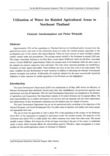Utilization of Water for Rainfed Agricultural Areas in Northeast Thailand
JIRCAS international symposium series
| ISSN | 13406108 |
|---|---|
| NII recode ID (NCID) | AA1100908X |

Full text
intlsymp-10_87-92.pdf192.79 KB
Approximately 70% of the population in Thailand derives its livelihood and/or income from the agricultural sector, and most of the cultivation areas are under the rainfed system, especially in the northeastern part of the country (the Isaarn Region). There are three sources of water available, namely rainfall, surface water and groundwater. The average annual rainfall in the Northeast is around 1,350 mm. The largest watershed, draining to the Mun River, covers about 70,000 km2 while the Chi River watershed covers a further 50,000 km2, approximately. Paddy rice occupies most of the lowlands, while the main crops in the uplands are cassava, sugarcane, bean and maize. The main water resources problems are insufficiency, fluctuation of water regime and quality. These problems can occur at any time, even in the rainy season. This paper considers the past development of water resources in addition to discussing the National Government's present strategies and policies. Additionally, the methods adopted for the most economically beneficial utilization of water resources for rainfed agriculture in the Northeast are also highlighted.
| Creator | Chaiyasit Anecksamphant Pichai Wichaidit |
|---|---|
| Publisher | Japan International Research Center for Agricultural Sciences |
| Available Online | |
| Issue | 10 |
| spage | 87 |
| epage | 92 |
| Language | eng |
